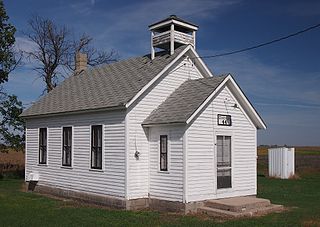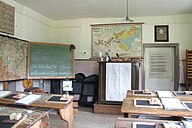
Jefferson County School District R-1 is a school district in Jefferson County, Colorado. The district is headquartered at the Jeffco Public Schools Education Center in West Pleasant View, an unincorporated area of the county near Golden in the Denver metropolitan area. Jeffco Public Schools serves almost 81,000 students in 166 schools. It is the second-largest school district in Colorado, having been surpassed in 2013 by Denver Public Schools, which has an enrollment of approximately 81,000.
The Howard County Public School System (HCPSS) is the school district that manages and runs the public schools of Howard County, Maryland. It operates under the supervision of an elected, eight-member Board of Education. Jennifer Mallo is the chair of the board. William J. Barnes has been the acting superintendent since January 2024.

Sanibel Colored School, also known as Sanibel School, is a U.S. National Registered Historic school located in Sanibel, Florida. Starting all the way from 1914, schooling in Sanibel started from a Baptist church that James Johnson built on Sanibel Island. Thirteen years later, Johnson gave black families the opportunity to use the church for schooling for the children which later resulted in the Lee County Board of Public Instruction buying it for a little over $1,000. Schooling with them was a little bit different from regular schooling, because they only needed seven children in order to operate school with grades 1-8. With the population in Sanibel being 90 people, it was a little hard to keep up with the school because children were 9th-12th graders. A little after, it got to the point where the school had to close their doors. In the year of 1962, the Lee County School Board put the schools up for sale.

Chana School is a Registered Historic Place in Ogle County, Illinois, in the county seat of Oregon, Illinois. One of six Oregon sites listed on the Register, the school is an oddly shaped, two-room schoolhouse which has been moved from its original location. Chana School joined the Register in 2005 as an education museum.

Avilla R-13 School District or Avilla R-XIII School District is a rural public elementary and middle school located in Avilla, Missouri, USA. For grades kindergarten through eight, it is the only school in the district. In the 2000 census, the district schooled 153 pupils and had 13 teachers on staff. Programs include basketball and agriculture, and the school boasts a low student to teacher ratio. Avilla is located at 37°11′38″N94°07′44″W, in Jasper County ten miles east of Carthage, Missouri on MO Route 96 and four miles west of the Lawrence County line.

The Plainview-Old Bethpage Central School District (POBCSD) is the public school district which serves the Nassau County, Long Island communities of Plainview and Old Bethpage, as well as small parts of Farmingdale.

The Mount Hanley Schoolhouse Museum is a community museum located in a historic one-room school in Mount Hanley, Annapolis County, Nova Scotia. The museum focuses on the history of Mount Hanley and surrounding communities as well as rural school life and the famous mariner Joshua Slocum who attended the school in the 1850s.

The Schoolhouse is an exhibit building at Shelburne Museum in Shelburne, Vermont. It was originally located in Vergennes, Vermont.

The Pioneer School stands in an isolated location in Park County, Wyoming, about 8 miles (13 km) north of Clark, in the Clark Fork Valley near the Montana border. The frame structure is an example of a country school built to serve students in rural areas prior to the introduction of school bus routes to more centrally located facilities. Built in 1914, it was a one-room schoolhouse until 1953, and it operated until 1967.

The historic Abbe Creek School is a one-room schoolhouse museum located one mile west of Mt. Vernon, Iowa, on E48. It is believed to be the oldest standing one room brick schoolhouse in Iowa. The school is located on land claimed by William Abbe, the first white settler in Linn County, Iowa.
The Greenfield Park One Room Schoolhouse is located in the town of Wawarsing in Ulster County, New York, United States. This one-room schoolhouse was built in 1830 and was home to grades one through eight. It was operated by one teacher and one school trustee. Its former students restored it to its present condition after forming the "Greenfield Park Historical Association" in 1960.

Clay County Schools (CCS) manages the public school system in Clay County, North Carolina. It is the only school district in Clay County and covers all of the county with about 1,200 students attending a total of 4 separate schools located on a central campus in Hayesville. After county government, Clay County Schools is the county's largest employer with a staff of 205 people.

The Drennan School, also known as the Drennan Community Building, is a historic building in Ellicott, near Colorado Springs, Colorado. The building was first owned by the Widefield School District in El Paso County. It is on the National Register of Historic Places.

Forest Grove School No. 5 is a historic building located near Bettendorf, Iowa, United States. It was listed on the National Register of Historic Places in 2013.

District No. 44 School is a historic one-room school in Taylor Township, Minnesota, United States. It was built in 1891 and used until 1954. The school building was listed on the National Register of Historic Places in 2011 for having local significance in the theme of education. It was nominated for being a well-preserved example of the one-room schoolhouses once common in rural Traverse County.

The Espanola Schoolhouse is a one-story; one-room rural school building that has survived from the Jim Crow racial segregation-era. It is the last standing one-room schoolhouse in Flagler County. It is located at 98 Knox Jones Avenue, Bunnell, Florida 32110.

The Westwood Community School District is a rural public school district headquartered in Sloan, Iowa. It spans northern Monona County and southern Woodbury County It serves the towns of Sloan, Hornick, Salix, Smithland, and the surrounding rural areas.
Des Moines Township No. 7, also known as Cole School, is a historic building located northeast of Boone in rural Boone County, United States. The brick one-room schoolhouse was completed in 1888. The use of brick suggests the people in this area were either people of some wealth or there was a larger population who could draw on a broader base of financial resources. Student records were not kept until the year after the school opened. At that time there were 19 students who were between the ages of 5 and 16. Nellie Harvey was the first teacher, and she and those who came after her worked with the students from first grade to eighth. In addition to being a schoolhouse, the building also served as a voting place, a community center, and a storm shelter. As the number of farm families in the area diminished the enrollment in the school declined. Educational leaders began to advocate for better educational offerings and improved school buildings. In 1920 the Iowa General Assembly passed laws to improve rural schools. During the Great Depression more families left the farms and the school closed in 1933. Two of the students who attended the school when it opened had sons in the final class of eight students.

A two-room schoolhouse is a larger version of the one-room schoolhouse, with many of the same characteristics, providing the facility for primary and secondary education in a small community or rural area. While providing the same function as a contemporary primary school or secondary school building, a small multi-room school house is more similar to a one-room schoolhouse, both being architecturally very simple structures. While once very common in rural areas of many countries, one and two-room schools have largely been replaced although some are still operating. Having a second classroom allowed for two teachers to operate at the school, serving a larger number of schoolchildren and/or more grade levels. Architecturally, they could be slightly more complex, but were still usually very simple. In some areas, a two-room school indicated the village or town was more prosperous.
Sagaponack Common School District is a public school district located in Sagaponack on Long Island, in Suffolk County, New York, United States. It is roughly co-extensive with the village of Sagaponack, which is part of the town of Southampton.







































